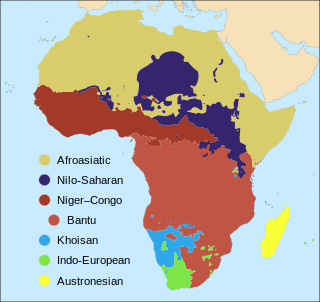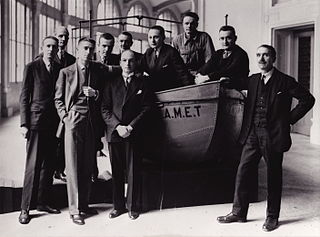Related Research Articles

The Cushitic languages are a branch of the Afroasiatic language family. They are spoken primarily in the Horn of Africa, with minorities speaking Cushitic languages to the north in Egypt and Sudan, and to the south in Kenya and Tanzania. As of 2012, the Cushitic languages with over one million speakers were Oromo, Somali, Beja, Afar, Hadiyya, Kambaata, and Sidama.

The number of languages natively spoken in Africa is variously estimated at between 1,250 and 2,100, and by some counts at over 3,000. Nigeria alone has over 500 languages, one of the greatest concentrations of linguistic diversity in the world. The languages of Africa belong to many distinct language families, among which the largest are:
Amharic is an Ethiopian Semitic language, which is a subgrouping within the Semitic branch of the Afroasiatic languages. It is spoken as a first language by the Amharas, and also serves as a lingua franca for all other populations residing in major cities and towns in Ethiopia.
Afar is an Afroasiatic language belonging to the Cushitic branch. It is spoken by the Afar people inhabiting Djibouti, Eritrea and Ethiopia.
The Agaw or Central Cushitic languages are Afro-Asiatic languages spoken by several groups in Ethiopia and, in one case, Eritrea. They form the main substratum influence on Amharic and other Ethiopian Semitic languages.

Marcel Griaule was a French author and anthropologist known for his studies of the Dogon people of West Africa, and for pioneering ethnographic field studies in France. He worked together with Germaine Dieterlen and Jean Rouch on African subjects. His publications number over 170 books and articles for scholarly journals.
Kayliñña is one of two Agaw languages formerly spoken by a subgroup of the Beta Israel. It is a dialect of Qimant. The name Kayla (ካይላ) is sometimes also used as a cover term for both Beta Israel dialects. It is known only from unpublished notes by Jacques Faitlovitch written in the Ge'ez script, recently studied by David Appleyard. It is preserved by the Beta Israel today.
Lowland East Cushitic is a group of roughly two dozen diverse languages of the Cushitic branch of the Afro-Asiatic family. Its largest representatives are Oromo and Somali.
The Qemant are a small Cushitic ethnic group in northwestern Ethiopia, specifically in Gondar, Amhara Region. The Qemant people traditionally practiced an early Pagan-Hebraic religion, however most members of the Qemant are followers of the Ethiopian Orthodox Church. Despite their historic relationship, they should not be confused with the Beta Israel.

The Agaw or Agew are a Cushitic ethnic group native to the northern highlands of Ethiopia and neighboring Eritrea. They speak the Agaw languages, also known as the Central Cushitic languages, which belong to the Cushitic branch of the Afroasiatic language family, and are therefore closely related to peoples speaking other Cushitic languages.
Sidama or Sidaamu Afoo is an Afro-Asiatic language belonging to the Highland East Cushitic branch of the Cushitic family. It is spoken in parts of southern Ethiopia by the Sidama people, particularly in the densely populated Sidama National Regional State (SNRS). Sidaamu Afoo is the ethnic autonym for the language, while Sidaminya is its name in Amharic. Although it is not known to have any specific dialects, it shares over 64% lexical similarity with Alaba-K'abeena, 62% with Kambaata, and 53% with Hadiyya, all of which are other languages spoken in southwestern Ethiopia. The word order is typically SOV. Sidaama has over 100,000 L2 speakers. The literacy rate for L1 speakers is 1%-5%, while for L2 speakers it is 20%. In terms of its writing, Sidaama used an Ethiopic script up until 1993, from which point forward it has used a Latin script.
Siltʼe is an Ethiopian Semitic language spoken in central Ethiopia. A member of the Afroasiatic family, its speakers are the Siltʼe, who mainly inhabit the Siltʼe Zone in the Southern Nations, Nationalities, and Peoples' Region. Speakers of the Wolane dialect mainly inhabit the Kokir Gedebano district of Gurage Zone, as well as the neighbouring Seden Sodo district of the Oromia Region. Some have also settled in urban areas in other parts of the country, especially Addis Ababa.

The languages of Ethiopia include the official languages of Ethiopia, its national and regional languages, and a large number of minority languages, as well as foreign languages.

Wolf Leslau was a scholar of Semitic languages and one of the foremost authorities on Semitic languages of Ethiopia.
The Awngi language, in older publications also called Awiya, is a Central Cushitic language spoken by the Awi people, living in Central Gojjam in northwestern Ethiopia.
The Awi people are an ethnic group in Ethiopia and are one of the Agaw peoples. The Awi live in Agew Awi Zone west of Mirab Gojjam and have a few communities in the Metekel Zone of the Benishangul-Gumuz Region.
The Qimant language is a highly endangered language spoken by a small and elderly fraction of the Qemant people in northern Ethiopia, mainly in the Chilga woreda in Semien Gondar Zone between Gondar and Metemma.
David Appleyard is a British academic and an specialist in Ethiopian languages and linguistics.
The Weyto are a caste living in the Amhara region along the shore of Lake Tana in northern Ethiopia. They worship the Nile River. They currently live in Bahir Dar, Abirgha, Dembiya and Alefa. The Weyto also made up part of the population of the Blue Nile Falls and Fogera, where currently their presence has not been ascertained.
Gumuz is a dialect cluster spoken along the border of Ethiopia and Sudan. It has been tentatively classified within the Nilo-Saharan family. Most Ethiopian speakers live in Kamashi Zone and Metekel Zone of the Benishangul-Gumuz Region, although a group of 1,000 reportedly live outside the town of Welkite. The Sudanese speakers live in the area east of Er Roseires, around Famaka and Fazoglo on the Blue Nile, extending north along the border. Dimmendaal et al. (2019) suspect that the poorly attested varieties spoken along the river constitute a distinct language, Kadallu.